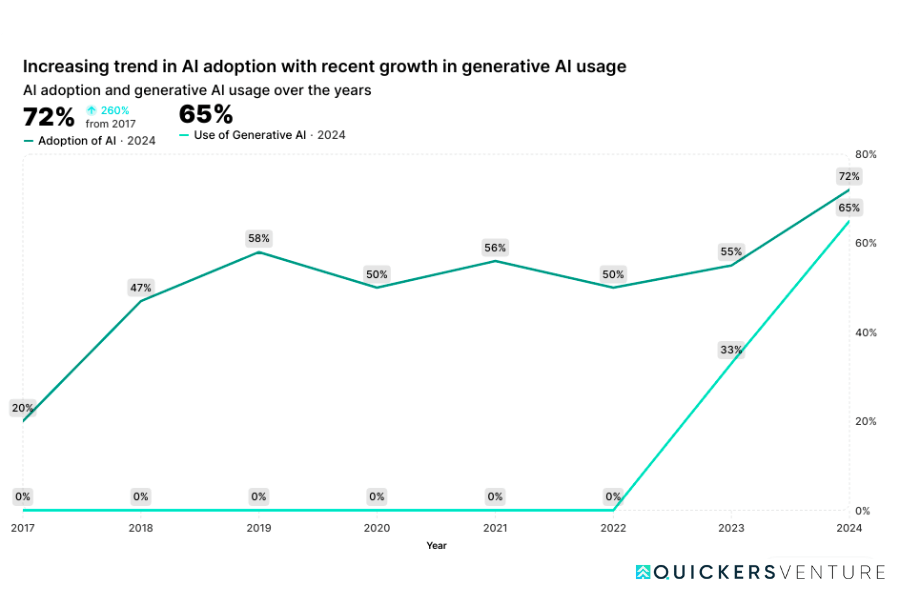The Real Cost of “Doing Everything Yourself”
If you’re an early-stage founder, you’ve likely worn every hat from CEO to support rep to part-time janitor. But the real drain isn’t the hours, it’s the constant context switching. LLMs aren’t here to replace your vision or grit, but they can offload the repetitive grind. Used right, they are more than assistants; they are operational force multipliers.

Source: McKinsey Global Survey on AI, 1,363 participants, Feb 22–Mar 5, 2024
In 2017, the definition for AI adoption was using AI in a core part of the organization’s business or at scale. In 2018 and 2019, the definition was embedded with at least 1 AI capability. Since 2020, the definition has been adopted in at least 1 function.”
1. The Myth of the 10x Founder Is Breaking
Founders don’t scale linearly. LLMs do.
Startups often glorify the 10x founder, but even the best hit a wall when they become the bottleneck. The real drag isn’t the big decisions; it’s the flood of “non-core” tasks: pitch decks, emails, job posts, CRM updates, and endless doc rewrites. First Round Capital reports that 80% of founders spend at least a third of their time on this kind of work.
LLMs change the game—not as flashy tools, but as tireless, context-aware knowledge workers who can draft, summarize, and respond without burning out.
Takeaway: Your bottleneck isn’t talent or capital—it’s how much of your time is spent doing what a machine can now do passably well.
2. Not Just Writing: LLMs as Context-Carriers
Delegation only works when there’s shared memory.
Founders often avoid delegating because explaining takes more time than doing. But LLMs are evolving into contextual systems—able to retain your startup’s data, tone, and workflows. They’re not just content generators anymore; they’re memory-driven collaborators that understand your pitch, product, and customer voice. It’s not automation for its own sake—it’s support tailored to how you work.
Takeaway: Don’t ask, “Can it write this email?” Ask, “Can it write it like me, based on what it knows about my company?”
3. Where LLMs Shine: The Founder Ops Stack
Think of it like a Chief of Staff that never sleeps.
The most high-leverage LLM use cases aren’t code or creativity—they’re in the murky middle: operational writing, structured reasoning, and communications-heavy workflows.
Here’s where AI can go from toy to tool in your day-to-day:
Founder Task Automation: LLMs vs Traditional Approach
| Task | Traditional Approach | With LLM/AI Copilot | Time Saved |
| Writing Investor Updates | Manually gather metrics, write a narrative | Auto-pull KPIs + draft summary in founder voice | 1–2 hours |
| Candidate Outreach | Manually write intro emails, screen resumes | AI-drafted emails + keyword-based resume scoring | 3–4 hours/week |
| Customer Ticket Summaries | Manually tag/support doc creation | AI summarizes issues + drafts reply suggestions | 30 mins/day |
| Drafting Product Specs | Organize notes from Slack/whiteboards | AI turns discussion into a structured PRD in Notion | 1–2 hours |
| Writing Job Descriptions | Write from scratch each time | AI pulls from team needs + auto-generates description | 45 mins |
| Fundraising Research & Emails | Google VC info + cold email writing | AI builds VC briefs + drafts tailored outreach emails | 2–3 hours |
Takeaway: AI works best where founder time is most fragmented—communications and coordination. It’s not about removing humans; it’s about removing the drudgery.
4. From Tool to Team Member: AI Ops Onboarding Checklist
Start small, stay specific, and build from the center out
You don’t need to build full-on AI agents to get started. Here’s a founder-tested checklist for getting LLMs into your real workflows:
Startup AI Ops Onboarding Checklist
Start here to delegate your first 10% of founder busywork.
| Step | Description | Recommended Tools |
| 1. Identify high-friction tasks | List 3–5 recurring tasks that feel repetitive or mentally draining | Pen + paper or Notion |
| 2. Pick your AI workspace | Choose where AI will live (e.g., Notion, Slack, CRM, email) | Notion AI, ChatGPT, Superhuman AI |
| 3. Centralize the startup context | Upload company info: pitch deck, customer profiles, product docs | ChatGPT with memory or Claude Opus |
| 4. Set up data permissions | Ensure you’re not exposing sensitive data unintentionally | Drive access control, Slack settings |
| 5. Create AI workflows for 1–2 tasks | Start with investor updates, job descriptions, or customer comms | Zapier, LangChain, Make (Integromat) |
| 6. Review + edit outputs manually | Keep a human in the loop—AI needs guardrails to learn your tone and logic | You / co-founder / EA review |
| 7. Automate the feedback loop | Train your assistant with corrections, feedback, and structured guidance | Custom GPTs, AutoGen, Rewind.ai |
| 8. Track time saved weekly | Compare before vs. after across at least 2–3 sprints | Manual tracking or RescueTime |
Takeaway: Don’t try to “AI everything.” Build trust in small wins. Prove value to yourself and your team first.
5. The Real ROI: Mental Bandwidth
AI doesn’t just save time. It saves cognitive capacity
Time saved is easy to measure. But the real dividend of offloading repetitive tasks isn’t time, it’s the ability to stay in flow. To focus on the hard stuff: hiring, product-market fit, fundraising, or surviving long enough to pivot.
Founders who embrace AI tooling report faster time to MVP, more consistent team alignment, and clearer investor communication. But most importantly, they spend less time feeling like their own executive assistant.
According to a 2024 McKinsey report, early-stage startups using AI tooling for ops reported 20–40% faster execution on internal processes, and founders self-reported feeling “significantly less burned out.”
Takeaway: It’s not about doing more. It’s about thinking less about what doesn’t matter.
Bonus: Let Tools Like Quickers Do the Heavy Lifting
You don’t need to build internal automations from scratch. Platforms like Quickers already offer AI-powered tools to handle the grind:
- Quick AI – Drafts job descriptions, emails, and updates in your tone
- Hyperautomation – Automates repetitive workflows like candidate outreach or support ticket summaries
- Startup Integration Suite – Syncs your data (pitch decks, CRM, etc.) so your AI actually understands your company
Try using Quickers to automate your first few ops tasks—like investor updates or hiring emails—and focus on what only you can do.
Final Thought: You’re Not Replacing Yourself. You’re Unburdening Yourself.
The best founders aren’t superhuman; they’re ruthlessly focused. In a world where execution speed is survival, letting go of the work you weren’t meant to do is the competitive advantage.
LLMs won’t replace your vision, your resilience, or your taste. But they will write that follow-up email, draft that update, and organize your notes, before your coffee’s cold.
And in a game where every edge compounds, that matters.
Pick one task this week. Hand it to your AI.
You don’t need a “GPT strategy.” You just need to reclaim your brain. Start there.

